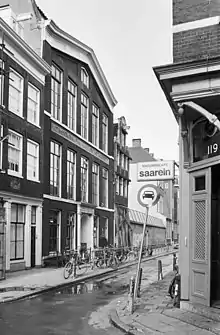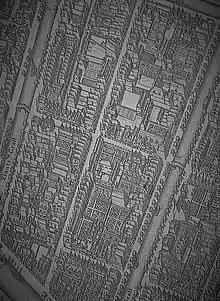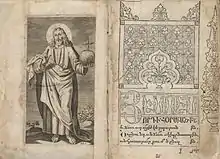Christoffel van Dijck
Christoffel van Dijck (c. 1600-5, Dexheim - November 1669, Amsterdam)[lower-alpha 1] was a German-born Dutch engraver and punchcutter, who engraved, cast and sold metal type. Although his career is poorly documented, he is believed to have been influential in the history of printing and typefounding in the Netherlands.[2][3][4]

Life

Van Dijck was born in Dexheim, now in Germany, to a Dutch Protestant family.[5] They came from Breberen (in the United Duchies of Jülich-Cleves-Berg), and settled near Frankfurt. His father Gilbert Breberenus van den Dijck was a Calvinist minister,[6] like his grandfather, uncle and his brother. Christoffel was trained as a goldsmith,[7] perhaps in Frankenthal, where Walloon and Flemish refugees (Calvinists) set up small manufacturies. By 1640 he moved to Amsterdam as a journeyman.[8]
Van Dijck changed career to become an engraver of steel punches, the masters used to stamp moulds, or matrices, used to cast metal type.[lower-alpha 2] How he began this career change is not documented; Lane speculates that he may have begun engraving types for other typefounders.[8] On 11 October 1642 he applied to marry Swaentje Harmens from Nordhorn, the widow of a former minister, giving his age as 36.[9] He lived at Jodenbreestraat but in 1645 he moved to an area for labourers and crafsmen called the Jordaan.
On 1 May 1647 he rented a house on the Bloemgracht in which he set up a type foundry.[5][8][10] This was a more prestigious address (although the house was in poor condition)[5] and close to the printing office of Joan Blaeu, who became a client.[8]
In 1664, a year of plague, he bought two houses in Elandsstraat, a former inn, barn and garden and borrowed money from two ministers.[11] He died in November 1669 and was buried in the nearby Westerkerk.
Career and legacy
Van Dijck became the most prominent type-founder of his time in the Netherlands,[12] cutting type in roman, italic, blackletter,[13] Armenian,[7] music type[14] and probably printers' flowers.[15] In or shortly before 1655 he drew out lettering for rooms in the Royal Palace of Amsterdam, then the city hall.[16]

Van Dijck worked extensively for Armenian printers in Amsterdam. On 27 November 1658 he contracted with the Armenian Matteos Tsaretsi (Matheos van Tsar in Dutch) to make punches and matrices to print an Armenian bible, and continued to work on Armenian types for the rest of his life.[18]
On his death, his foundry was taken over by his son Abraham (1645-1672), who was also a punchcutter.[19] Abraham van Dijck sold matrices to Thomas Marshall on behalf of Bishop John Fell in Oxford for Oxford University Press, many of which survive, as does Marshall's correspondence.[20][21][22] Marshall wrote to Fell in April 1670 that "this last winter had sent van Dijck and [Bartholomeus] Voskens, the two best artists in this country, to their graves."[20]
Abraham van Dijck suffered from poor health, documented in his and Marshall's correspondence,[23] and died prematurely in February 1672.[24][9] The following April the foundry was auctioned,[19] and bought by Daniel Elzevir.[25] In 1681 it was bought by Joseph Athias, the printer of books in Hebrew and who cooperated with the widow of Jan Jacobsz. Schipper printing English bibles.[26][25][27][19] In 1702 his son Manuel Athias sold his part in the foundry to the heir Cornelia Schipper.[28] In 1755 the family closed the business at Nieuwe Herengracht; the foundry was bought by Jan Roman the younger (1709-1770), bookseller in the Kalverstraat.[29] In 1767 the foundry was auctioned again,[30] and materials bought by both the Enschedé foundry in Haarlem and the Ploos van Amstel brothers in Amsterdam, the latter bought by Enschedé in 1799.[30][31]
Work

From a surviving 1681 specimen, historian Paul Shaw explains that van Dijck's aesthetic style is "closer in color and spirit to 16th-century French types such as those by Garamont than to those of his contemporaries, which tend to be darker, narrower, and have a taller x-height (a combination often described by type historians as le goût Hollandois)."[32] His blackletter types are ornate, with many teardrop terminals, especially on the capitals, apparently following the lead of types cut by Nicolaes Briot.[13]
Understanding of van Dijck's career has been limited by a lack of knowledge of what types he cut: as was common for pre-nineteenth century printing materials a large proportion of his punches and matrices were lost due to changing artistic tastes in favour of "modern face" typefaces, being destroyed from around 1808 by Enschedé at a time when it was also in financial difficulties, although some survive at Enschedé,[33] and others in the collection of Oxford University Press.[21] An impressive but jumbled specimen was issued by the widow of Daniel Elzevir in 1681 offering what had been his foundry for sale, of which a single copy survives in the Plantin-Moretus Museum of Antwerp.[34][35][12][25] Fragments of an earlier specimen are also extant at Cambridge University Library.[2] A specimen issued by van Dijck in 1668/1669 was found to exist in the National Archives in London by historian Justin Howes;[36] according to John A. Lane as of 2013 it had yet to be published.[16][37]
Besides van Dijck's own types, his foundry apparently owned some older types: by the year after his death Abraham van Dijck owned matrices for a Greek type cut by Robert Granjon in Garmond size.[38] Marshall bought matrices for this type which survive at Oxford University Press, probably from Abraham van Dijck, or possibly another source in the Netherlands; if they did come from van Dijck his foundry was apparently able to replace them with another set of matrices, since the type is advertised on the 1681 specimen.[38] On the 1681 specimen a number of other types are also by Granjon, with one titling and one roman by Claude Garamond and another titling by Hendrik van den Keere.[21] According to Marshall Amsterdam typefounders were able to buy earlier types from Frankfurt.[30][39]
Several digital fonts based on van Dijck's work have been published, including DTL Elzevir (1992) by Dutch Type Library.[40]
References
- Lane 2012, p. 70.
- McKitterick, David J. (1977). "A Type Specimen of Christoffel van Dijck?". Quaerendo. 7 (1): 66–75. doi:10.1163/157006977X00062.
- Middendorp, Jan (2004). Dutch Type. 010 Publishers. pp. 23–25. ISBN 978-90-6450-460-0.
- Designer info by Luc Devroye
- Lane 1993, p. 26.
- Lane 2012, p. 73.
- Lane 2012.
- Lane 2012, p. 74.
- Hoeflake 1973, p. 114.
- De Amsterdamse boekhandel 1680-1725. Deel 5. De boekhandel van de Republiek 1572-1795(1978)–Isabella Henriëtte van Eeghen
- Notarial deeds by Van Dijck: notice of marriage, baptism of his son, purchase of the houses, and burial record; see also Van Eeghen, p. 277-279, 282, 287-288.
- Lane, John A. (2004). Early Type Specimens in the Plantin-Moretus Museum. Oak Knoll Press. pp. 45–9. ISBN 9781584561392.
- Lane 1993, p. 64.
- Lane 1993, pp. 65-66.
- Lane 1993, p. 88.
- Lane, John A. (27 June 2013). "The Printing Office of Gerrit Harmansz van Riemsdijck, Israël Abrahamsz de Paull, Abraham Olofsz, Andries Pietersz, Jan Claesz Groenewoudt & Elizabeth Abrahams Wiaer c.1660-1709". Quaerendo. 43 (4): 311–439. doi:10.1163/15700690-12341283.
- Lane 2012, pp. 77-78.
- Lane 2012, p. 86.
- Hoeflake 1973, p. 115.
- Hart 1900, p. 161.
- Dreyfus 1963, pp. 17-18.
- Ould 2013, pp. 215-6.
- Hart 1900, pp. 162-3.
- Hart 1900, p. 171.
- Dreyfus 1963, p. 16.
- M.M. Kleerkooper, De boekhandel te Amsterdam voornamelijk in de 17e eeuw, deel 1
- Lane 2012, p. 105.
- Familiearchief Cambier. In: Nationaal Archief
- Van Eeghen, p. 301
- Dreyfus 1963, p. 17.
- Hoeflake 1973, p. 116.
- Shaw 2017, p. 63.
- Lane 1993, pp. 57, 64.
- Mosley, James. "Elzevir Letter". Typefoundry (blog). Retrieved 7 November 2017.
- Shaw 2017, pp. 63-4.
- "Proeven van alle de LETTEREN die Gesneden zijn van Christoffel van Dyck". National Archives. Retrieved 4 July 2019.
- "John Lane & Mathieu Lommen: ATypI Amsterdam Presentation". YouTube. ATypI. Retrieved 12 July 2019.
- Lane 1996, p. 116.
- Hart 1900, p. 166.
- "DTL Elzevir". Dutch Type Library. Retrieved 6 September 2020.
Cited literature
- Dreyfus, John, ed. (1963). Type Specimen Facsimiles. London: Bowes & Bowes, Putnam. pp. 16–18.
- Enschedé, Johannes; Lane, John A. (1993). The Enschedé type specimens of 1768 and 1773: a facsimile ([Nachdr. d. Ausg.] 1768. ed.). Stichting Museum Enschedé, the Enschedé Font Foundry, Uitgeverij De Buitenkant. pp. 29–30 etc. ISBN 9070386585.
- Hart, Horace (1900). Notes on a Century of Typography at the University Press, Oxford, 1693-1794. Oxford: Oxford University Press. Retrieved 6 September 2020.
- Hoeflake, Netty (1973-06-07). "Van Dijck". A Tally of Types. CUP Archive. pp. 113–6. ISBN 978-0-521-09786-4.
- Lane, John A. (1996). "From the Grecs du Roi to the Homer Greek: Two Centuries of Greek Printing Types in the Wake of Garamond". In Macrakis, Michael S. (ed.). Greek Letters: From Tablets to Pixels. Oak Knoll Press. ISBN 9781884718274.
- Lane, John A. (2012). The Diaspora of Armenian Printing, 1512-2012. Amsterdam: Special Collections of the University of Amsterdam. pp. 70–86, 211–213. ISBN 9789081926409.
- Ould, Martyn (November 2013). Gadd, Ian (ed.). History of Oxford University Press: Volume I: Beginnings to 1780. Oxford University Press. pp. 212–221. ISBN 978-0-19-955731-8.
- Shaw, Paul (18 April 2017). Revival Type: Digital Typefaces Inspired by the Past. Yale University Press. pp. 48, 61. ISBN 978-0-300-21929-6.CS1 maint: ref=harv (link)
Notes
- Date of birth taken from Lane 2012, although in his marriage application van Dijck gave his age as 36 meaning a year of birth of 1606/7.[1]
- Technically in metal typesetting a distinction is made between the adjustable mould that casts the main body of the type, and the matrix, which is the mould only for the letter shape.